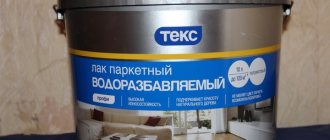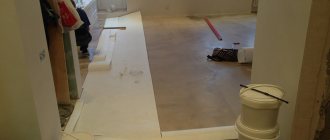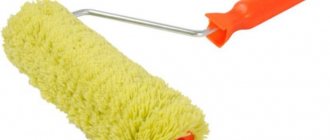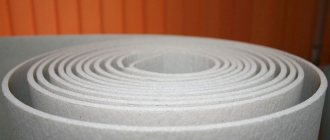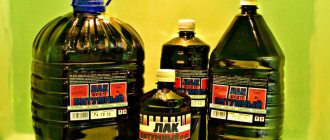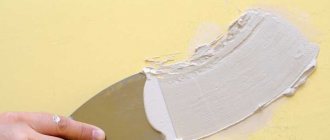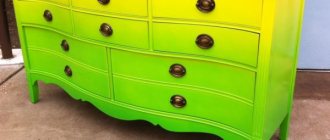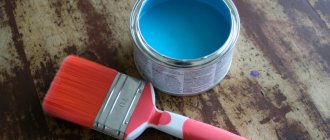Since its inception, parquet has been one of the elite class floor coverings. The natural wood color in combination with an unusual pattern on a subconscious level creates a feeling of comfort and homely warmth in a person. But maintaining an elegant appearance requires careful handling of parquet. Various means can be used to protect the material, but varnish is considered the most popular. High-quality varnishing of parquet will breathe new life into the flooring, due to which the room will regain its original appearance.
Parquet varnishing
Features of the material
Parquet is a practical, but quite expensive floor covering that can last for decades. With the help of this material, the owner of the house can not only create comfort and tranquility, but also emphasize the status of his home. Periodic varnishing will protect the surface of the parquet by creating a special glossy film on it.
Parquet floor
When finishing parquet, you can use not only transparent varieties of varnish that do not affect the color of the wood in any way, but also tinting agents . The latter are able to change the shade of the floor covering, thereby modifying the entire room.
Installation of parquet on a screed without plywood
Solid boards and piece parquet
Prices for Tarkett parquet
Tarquette parquet
Materials for coating parquet with varnish
Not every property owner knows how to cover the parquet after sanding. Before varnishing, you can apply the following solutions to the floor covering:
- Antiseptics protect wood flooring from damage by fungus and mold, and protect against the effects of microorganisms and insects.
- Fire retardants increase the fire-fighting properties of parquet and protect the surface from fire as a result of the influence of open fire.
- Water-repellent impregnation penetrates deeply into the pores of the wood, preventing exposure to moisture, which leads to deformation of the dies.
Important! Special attention must be paid to the primer. This composition fills all microscopic cracks and improves the adhesion of the base surface. The primer is not applied before impregnating the parquet with oil.
Special compounds will help change the base color of the floor covering. How to tint parquet before applying varnish. To do this, you can use colored oil or a special solution, stain. Such substances highlight the wood texture and improve the depth of shades even for light flooring options.
Colored oil with special coloring pigments gives the parquet a beautiful noble tone and highlights the wood texture. This solution consists of natural components; after its application, you can obtain a coating that is resistant to moisture and chemical detergents. Using oil, you can artificially age wood, but to do this you need to walk over the surface with a hard metal brush.
Interesting article on the topic: Panel parquet: types and installation
A good effect can be achieved by using stain. This composition allows you to obtain a smooth, rich floor covering. The stain penetrates deep into the structure of the material, but the pores are not clogged, allowing the wood to breathe.
Varnish selection
Having decided to varnish a parquet floor, you need to allocate time for work, prepare tools, and also purchase varnish. Construction stores offer many types of varnishes, differing in chemical composition and, of course, cost. Below are the most popular types of varnish.
Parquet varnishes
Table. Classification of varnishes for parquet.
| Type of varnish | Description |
| Alkyd | It consists of oil scraps, due to which the varnish takes longer to dry than other types. The disadvantages of alkyd varnish include high toxicity. |
| Urethane-alkyd | A highly durable, non-toxic product for parquet floors. Urethane-alkyd varnish is quite expensive, but this does not prevent it from being one of the most popular products for parquet. |
| Acrylic | Acrylic varnish contains acrylate copolymers. The material does not have a persistent odor, and it is also safe for the body of adults and children. The disadvantages include the high cost. |
| Polyurethane | Wear-resistant composition that contains polyurethane and other chemical components. The varnish is mainly used for work in commercial premises. |
| Primer | A separate type of varnish used exclusively to increase the adhesion of parquet or change its shade. Can be used in combination with other types of varnish. |
Prices for Loba parquet varnish
loba parquet varnish
Why do they polish parquet at all?
Before purchasing this or that type of varnish, you need to decide on the surface that you should end up with. Varnish can create a glossy, silky or matte surface, and this must be taken into account. Also, some types of varnish can change the color of parquet. It is also necessary to take into account the operating characteristics of the floor covering, or more precisely, the type of loads on the surface. Based on all the factors listed above, you can choose the most suitable remedy.
It is important to choose the right varnish
Correct choice
Before the process of painting parquet, you should decide on the choice of varnish. So, first decide what kind of picture you would like to see in the end. Depending on the choice of varnish, the floor can be semi-gloss, glossy, matte or even silky. Nowadays, there are several types of paints and varnishes for parquet.
Dispersion varnish for parquet is safe for human health
. Let's list them all:
- Primer. It is used for two reasons: firstly, the primer increases adhesion between the top layer of varnish and the parquet board, and secondly, the primer helps to fully reveal the natural beauty of the wood.
- Dispersive. It does not contain solvents, which explains its complete safety for human health. Due to the fact that one of the important components is water, you can independently come to the conclusion that dispersion varnish is highly resistant to moisture. Another advantage is the fact that it does not glue parquet boards together. Such varnishes can provide high quality coating.
- Alkyd. The composition is harmful to human health, because in addition to artificial oil resins, it contains White Spirit solvent. Drying time is quite long.
- Acid curing varnish. One of the cheapest options that has good protective properties, but requires caution during work. The fact is that this solution contains formaldehyde.
- Polyurethane anhydrous. Like the previous one, it has high protective properties. In addition, it is worth noting increased adhesion and resistance to chemical exposure. Be careful: since it contains no water, it is quite susceptible to damp wood.
Video about the benefits of varnishes and oils for parquet
Tools and materials
To coat a parquet floor with varnish, you need to prepare the following:
- impregnation, glaze or other means to reduce varnish consumption and close pores . The product can be tonic, filling or antiseptic;
- a vacuum cleaner to clean the floor surface from dust (it is advisable to use an industrial type device);
- sealant or putty for sealing various defects, such as chips, small cracks or crevices;
- plastic or metal container for mixing products;
- roller and paint brushes for applying varnish . A spray bottle or a regular sponge can also be used;
We prepare the necessary tools
- putty knife;
- fine-grained sandpaper (if possible, you can use a belt sander);
- protective gloves;
- tape or masking tape to protect walls;
- paint tool cleaner.
Sander
Note! Before work, you need to carefully study the instructions, since paint compositions from different manufacturers may have different consumption and drying times.
Prices for polyurethane parquet varnish
polyurethane parquet varnish
Applying varnish to parquet
There are two ways to apply varnish to the floor surface - using a roller and brush, or using a spray bottle. We recommend the first method, since it is the simplest and, if you follow simple rules, guarantees a perfectly smooth surface without streaks.
So, let's look at how to paint parquet with varnish. First, coat the surface of the parquet board with a primer.
Important: not every varnish requires a primer first.
Moreover, there are varnishes that do not require the use of a primer layer at all. After the primer layer is on the surface, wait until it is absorbed. You can lightly sand the surface using fine-grit sandpaper. This is already done manually.
We take the roller in our hands, dip it in the paint tray (this way you ensure that there is no excess varnish left on the roller) and begin to move from the far side of the room. The varnish should be applied with a roller strictly in one direction. Moreover, having made one strip along the wall, the next time we go over it with a roller so that it overlaps the previous strip no more than a quarter, and the remaining three quarters paint the clean floor. Do this until you have applied the first layer to the entire surface of the floor indoors.
Next, you need to wait for the first layer to dry, after which, taking fine-grained sandpaper in your hands, clean the surface by hand.
It is not always necessary to apply a primer to it before varnishing parquet.
We remove dust with an industrial vacuum cleaner, if possible wash the surface with a rag soaked in warm water (only in the case of moisture-resistant varnish), and apply a second layer. There are also two ways to apply a second layer to the surface. The first method involves applying a layer to the surface in the same direction as before. The second method is to apply the varnish perpendicular to the previous layer. Both methods are effective. We can stop here. If you want to make the surface more durable, you can apply a third layer. Between the second and third layers it is also necessary to clean the surface with fine-grained sandpaper.
Are you asking why you need a brush? It's very simple: not everywhere you can get to it with a roller. So, the areas under the radiator, as well as the corners of the rooms, need to be painted with a brush.
Material calculation
How much varnish will be needed for the repair? First you need to measure the length and width of the room in meters and multiply these numbers. The result should be the full area of the room. If the room has a more complex shape, for example, it is lined up with the letter “P” or “G,” then you need to divide the surface into rectangles and calculate the area of each of them. The values added together are the total floor area.
Calculator for calculating the area of a quadrangular room
Go to calculations
Determining the varnish consumption
After the calculations, you should study the information on the can of varnish. It shows the average consumption: how many square meters can be painted with one liter of varnish. It is very convenient when the can indicates the surface area that can be painted with one can when applied in one layer. Based on this information, you can calculate how much varnish is needed for a particular room.
Calculate in advance how much varnish will be needed for the parquet
How to prepare the floor?
Before you varnish your parquet floor, you need to prepare the surface. How to do it?
- If the parquet is old, you need to inspect it carefully. The heads of screws or nails should not stick out. The floor should not creak or collapse. If necessary, the parquet needs to be repaired and worn-out tiles replaced with new ones.
- Wash the floor thoroughly with water and detergents intended for parquet.
- When the surface is dry, remove the old varnish and protective wax. This can be done using white spirit or wax solvent.
- Scrape the surface if there are significant differences between the boards. A sanding machine allows you to level the surface and remove the darkened layer of wood. As a rule, scraping is performed in several approaches. In this way, you can remove from 8 to 15 mm of wood. Different types of wood require different sanding methods.
- Sand the surface using a sander. As a result, the floor will be completely leveled, and the wood will acquire a natural shade. Sanding is carried out in three passes: the first with coarse-grained sandpaper, the second with medium-grained sandpaper, and the third with fine-grained sandpaper. As a result of sanding, cracks or chips may appear on the parquet. They need to be sealed with wood putty, and then sanded again with fine sandpaper.
- Clean the base from dirt and dust using a construction vacuum cleaner.
The steps described are suitable not only for repairing old parquet, but also for new flooring. True, for newly laid parquet boards the list of work is reduced: the new parquet can be immediately sanded and varnished.
Starting to varnish parquet
Varnishing a floor is a very labor-intensive process consisting of several stages. We are talking about preparing the coating, removing dirt, applying primer and varnish. For a high-quality result, careful preparation is required. Below are step-by-step instructions for coating a parquet floor with varnish, following which will simplify this process.
Step 1. Prepare all the necessary tools for work. If the varnish is solvent-based, then in addition to the above materials, you need to prepare a solvent.
Preparing everything you need
Step 2: Remove the baseboards or protect them with masking tape.
Covering skirting boards with masking tape
Step 3. Cover the windows with paper or regular newspapers. This is done to protect the future coating from sunlight.
The windows are covered with newspapers
Step 4: Carefully inspect the floor. If you see protruding heads of nails or screws, press them deeper. If the floor was covered with a protective layer of wax, then it needs to be scraped off.
Floor inspection
Step 5. Clean the cracks between the parquet boards using a brush. All existing cracks must be filled with putty.
Preparing the floor surface
Step 6: Sand the floor with fine-grit sandpaper. If possible, you can use a sanding machine. This will significantly speed up the preparatory process.
Sanding the floor with sandpaper
Step 7 : Protect yourself before you start. Wear rubber gloves and work clothes that you don't mind. You also need to select a brush according to the width of the board.
Wear rubber gloves
Step 8: Start priming. Open the jar of soil and mix the contents with a wooden spatula or a ruler. Mix thoroughly, but gently so as not to create foam.
The primer is mixed
Step 9: Pour a small amount of soil into the tray and dilute it according to the manufacturer's recommendations.
The primer is diluted
Step 10: Start applying a coat of primer, moving the brush along the grain of the wood. If the primer is colored, paint one board from start to finish at a time. This will avoid changing shades.
Application of the composition
Step 11. Be careful not to leave any area of the floor untreated. Usually one layer of soil is sufficient.
You need to move along the fibers
Step 12. Wait until the primer is completely absorbed and dry. Check the jar - it indicates the drying time before the next layer.
Wait for the primer to dry
Important! After the primer has dried, the floor must be sanded again with fine sandpaper. Only after this can you start varnishing.
Step 13. Start varnishing. Mix the varnish thoroughly for 3-5 minutes. Start from the farthest corner and gradually work your way towards the exit.
Let's start applying varnish
Step 14: Hold the brush vertically so that only the tip of the brush touches the floor surface. You can use the same brush that was used to apply the primer.
The brush must be held vertically
Step 15: After applying the first coat of polish, wait until it dries completely. The time it takes for the polish to dry is indicated on the can.
Floor varnishing
Step 16: When the varnish is dry, carefully sand the first coat to remove any raised lint, bubbles, or stray debris.
Re-sanding the floor
Step 17: Remove any accumulated dust from your hardwood floors, then wipe the surface with a clean, lint-free cloth.
The floor surface is wiped
Step 18 Apply the next coat of varnish. The number of layers may depend on several factors (type of wood, quality of varnish, etc.), but practice shows that 2-3 layers of varnish will be enough.
Applying a second coat of varnish
Step 19. Apply the last layer from the window to the exit. There is no need to sand the floor after this – the floor already looks flawless. After a week, you can nail the baseboards into place (if they were previously removed) and bring in the furniture.
No need to sand the floor anymore
Why is parquet primer used?
Untreated parquet wears out faster, so it is necessary to prime the coating. Application of the composition before final finishing provides the following results:
- High-quality varnishing of lamellas. The primer levels out the parquet, filling cracks and closing pores.
- The correct composition emphasizes the natural shade and texture of the wood, preventing darkening and drying out of the lamellas.
- Even if the varnish gets between the slats, the lamellas will not stick together, which means that the risk of deformation is reduced and when replacing dies locally, you will not have to lift the entire base.
- If a primer is used for parquet, varnish consumption is significantly reduced.
- After priming, a protective film is formed on the surface, preventing the formation of mold and rot.
Primers for adhesive clean parquet from dust, level the surface, and serve as a good waterproofing and impregnating agent. Varnish compositions are used to increase the strength of the coating, increase wear resistance, protect against stains, loss of color and well prepare the coating for final varnishing.
Types of varnishes for parquet and selection rules
What problems might you encounter?
Often, after varnishing, defects may appear on the floor surface that greatly spoil the appearance of the room. Some of the defects arise due to the fault of the master himself, and some are due to low-quality paint and varnish materials. Let's look at the most common problems that you may encounter after varnishing a parquet floor.
Some difficulties may arise during varnishing
The varnish takes a long time to dry
Failure to comply with the technology for applying or mixing varnish (for example, not enough hardener has been added or the varnish layer is too thick). In this case, there is no need to resort to additional stimulation using heaters. Drying should be natural. The duration of polymerization can reach several weeks, and in some cases up to a month.
The varnish should dry naturally
Whitish stripes
Such defects on the parquet may appear due to the use of dirty tools. Unfortunately, it is impossible to eliminate the whitish streaks that appear. Therefore, before starting painting, all tools must be thoroughly cleaned.
It will not be possible to wash out whitish streaks
Multicolored parquet
There should be no drafts in the room during painting, as they will lead to uneven drying of the surface. Also, due to drafts, the parquet may become covered with small air bubbles.
Photo of parquet floor
Wrong shade
As you know, varnish is a chemical substance that can “burn through” wood, so the surface of the parquet darkens several tones. The change in shade depends on the type of wood. All these nuances must be taken into account at the painting planning stage.
The floor becomes darker after varnishing
Varnish peeling
It is not recommended to use formulations on different bases, as this is fraught with unpleasant consequences. All products must be purchased from one manufacturer, and if the varnish nevertheless begins to peel off after drying, then it will no longer be possible to save it. Re-varnishing of the parquet with preliminary removal of the coating is required.
On a note! Compliance with all the rules when varnishing will protect the parquet from various damages, as well as create an attractive appearance in the room. A well-applied varnish will last for many years.
What affects the service life of parquet
Which parquet varnish is better?
Before choosing a varnish to protect parquet flooring, you need to understand all the existing varieties, the strengths and weaknesses of each composition.
Polyurethane
The solution is made from acrylic, solvent or urethane chemicals. Polyurethane varnishes can be one-component or two-component. They contain a minimal amount of water, which speeds up the drying process of the protective layer.
The advantages of the composition include:
- resistance to sunlight;
- high speed of surface drying;
- elasticity of the coating;
- does not require prior application of primer;
- good fire resistance;
- excellent adhesion.
The main disadvantages of the composition under consideration are the possibility of swelling when drops of water get on the freshly laid solution, as well as gluing of adjacent parquet planks.
Water based varnish
Such compositions are made based on solvents, emulsifiers and water. The varnish is characterized by a long drying period due to the need for moisture evaporation. The advantages of the material include:
- high level of fire safety;
- no odor upon application;
- The protective coating does not swell when exposed to water.
The main disadvantages of water-based varnishes are the minimum level of wear resistance and the possibility of squeaks when walking if the composition gets into the cracks between the dies. In addition, this solution is not suitable for treating parquet boards made of beech or pine hornbeam.
Oil parquet varnishes
Particular attention should be paid to oil-based alkyd varnishes. Such compositions are well absorbed into the wood structure, protecting the surface from mechanical damage, emphasizing the natural beauty of the floor covering. The main disadvantages of oil varnish are the long drying period, as well as the low level of wear resistance of the protective coating.
The flooring is parquet and requires special care. This material is demanding on itself, but it is also environmentally friendly and safe. How to wash parquet and what to use, read the article
Additional recommendations
To avoid future problems when varnishing your floor, you must follow these recommendations:
- When using a two-component varnish, brushes must be washed after use . But if a one-component varnish is used, then the brushes can be left in the container without bothering with cleaning them;
Parquet restoration - before and after photos
- When varnishing a parquet floor with a roller, do not make diagonal movements . Otherwise, the varnish will lie on the surface in an uneven layer, which will ultimately lead to the appearance of streaks;
- Regardless of the type of varnish used, it is important to follow safety precautions when working . It must be remembered that varnish is a chemical substance. Prolonged inhalation may be harmful to health.
Observe safety precautions when applying varnish
Beginners who have not previously encountered parquet varnishing should understand that the surface may not turn out perfect the first time. Therefore, to begin with, it is advisable to practice on less noticeable areas of the floor. This will allow you to get the hang of it so that varnishing the main part of the floor is successful.
Types of primer mixtures
To select the composition, you should decide on its type and varieties. Manufacturers offer the following primer options:
- Alkyd. Today they are considered the best, dry in 6-10 hours and create a durable protective film on the surface of the coating. The second purpose is to give the boards a noble shade and solidity. The composition has a pungent odor, but is good for exotic wood species: merabou, jatoba, wenge and others. A large percentage of dry residue solves the problem of open wood pores - the primer “seals” them, which means that even under-dried lamellas will not release resins and are protected from the penetration of destructive salt into the body of the wood.
- Acrylic. They should be diluted with water, but such mixtures dry quickly and do not have a strong odor. The quality of the coating has no flaws, application is simple - there are no streaks, stripes, or overlaps left. Acrylic composition is more environmentally friendly than alkyd and therefore it is often used where careful treatment of parquet slats is required. Restrictions on use apply to wood species with poor absorbency, for example, bamboo, rosewood.
- Shellac. These are compositions based on the milky juice of insects mixed with ethyl alcohol. They are characterized by quick drying (30-40 minutes) and almost do not raise wood pile. This means that the surface will not require additional grinding. In addition, the alcohol base beautifully emphasizes the texture of the lamellas, highlighting the naturalness of the pattern. Shellac primer is a universal composition suitable for unstable types of wood: the absence of water in the mixture eliminates warping of the wood and “seals” the pores well. A small drawback is that there is a small dry residue, so you will have to cover the parquet not with one, but with several layers of varnish, so that there are no “bald spots” left.
- Dispersive. This is a universal primer that can be applied not only to parquet, but also to any other surface. Ideal for standard European parquet slats made of pine, larch, oak, ash. It has a high dry residue, does not require multi-layer varnish, and also does not have a strong odor. The mixture does not change the color of the parquet flooring, but is not always recommended for unstable wood species.
According to its intended purpose, parquet primer is divided into groups: for adhesive and for varnish. When choosing a composition, you need to take into account the type, characteristics of the base, adhesive composition, and varnish. If the varnish is based on polyurethane, a solvent, then the primer for parquet under the varnish must contain a solvent. But for water-dispersion varnish, an acrylic-based composition is considered good. If it is difficult to choose, professionals advise giving preference to alkyd mixtures - such compositions can be used for untreated dies.
What you need to know about varnishing parquet
The quality of varnished parquet flooring depends on:
- climatic indicators indoors during varnishing and when the coating dries;
- pattern of laying parquet boards;
- wood species;
- location of the room.
In accordance with the pattern in which the parquet is laid, the direction of movement of the roller or brush when applying varnish is determined. The type of wood material influences the choice of primer and varnish composition in order to ensure their compatibility.
First, all work on applying the varnish layer must be planned in accordance with the size and shape of the room. Varnishing is carried out moving towards the exit, so as not to drive yourself into a corner without the possibility of exit.
To carry out the work of applying varnish to a parquet floor, you need to create the following conditions:
- indoor humidity level is about 60%;
- air temperature in the range: from +15 to +250;
- there should be no drafts;
- bright sunlight should not be allowed to fall on the entire area of the parquet, not only when applying the varnish, but also when drying it;
- when using heating devices, you need to ensure that they operate at low power so that the parquet does not heat up too much;
- The humidity of small parquet flooring is no more than 10%, of large parquet flooring is no more than 6%. This is very important to observe, because when applying varnish to raw wood, after some time it will shrink, causing cracks to appear on the varnish coating. There will be a need to restore the parquet.
If the floors were previously covered with a wax or oil composition, parquet varnish cannot be applied. Wax or oil will interfere with the adhesion of the varnish layer to the wood, therefore, there will not be a good result.
Parquet varnish must be chosen taking into account the characteristics of the room:
- kitchen and bathroom - it is better to use a moisture-resistant type of varnish (waterless varnishes, polyurethane);
- corridor, hall, living room - you need wear-resistant, durable (waterless or formaldehyde varnishes);
- children's room - it is better to use water-soluble varnish with a short drying time. Varnishes that are safe for use in children's rooms are marked: EN 71.3;
- rooms with constantly high loads - high-strength varnishes (waterless, formaldehyde) should be used.
Caring for varnished parquet
For some time after processing the parquet, you should treat the coating with care and avoid excessive loads. This will help increase the service life of the varnished parquet floor. Try to do:
- You shouldn’t lay carpets on a still fresh floor soon; it’s better to wait a few days. It is advisable to glue pieces of soft fabric or felt to furniture legs.
- You cannot walk on the parquet floor in thin heels; change your shoes to soft slippers when entering the apartment.
- Place rugs at the front door. This creates a barrier to the penetration of dirt and excess moisture onto the parquet.
- It is recommended to treat the parquet with a product that refreshes the varnish coating once a year.
- The optimal humidity for parquet is 60%. Large deviations in one direction or the other can have consequences.
- It is necessary to wash the floor carefully, taking into account that excess moisture is terrible for parquet.
- The rag should not be very wet and should absorb water well.
- If you find small scratches on the parquet, you should immediately use restorative paste for an easy cosmetic update.
Now you know how to varnish a parquet board yourself, how to pre-prepare the floor for this, you know that in the first days after painting you need to be careful and careful so that the parquet serves you longer and looks great. Good luck.
